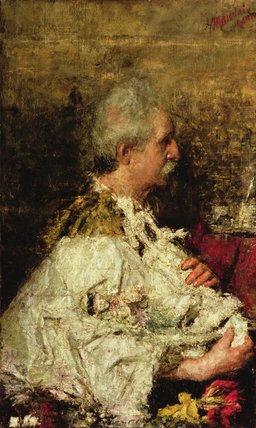The embodiment of a soul, the thoughts stirred by one painting of Antonio Mancini…
Cen Long
7/15/2016
By Antonio Mancini


The more profound the soul of one painting, the more touching it is. Regardless of the painting forms: abstract or figurative, painters hope to convey their spirit through their works and converse with the audiences, that it, to use the language of paintings to have a spiritual conversation with the viewers.


Antonio Mancini, Italian artist in the late nineteenth century, is like a psychic magician. He is capable of impregnating his artworks with the soul of those he portrays, that makes the substantiality of their palpable to the audiences. When I first came across a work of his, I was genuinely shocked and amazed; The gaze of his portraits mesmerized me, rendering me unable to forget them. There was a small oil portrait, called Ilchierickhetto, it depicts a young altar server during the Mass. The moment the painter captured, is the exact instant when the Hymn begins to ring. The young server than holds his breath and gazes, with his head tilted, at the sky above the church; the gentle grey of his pupil still shines of innocence and reverence. At this moment, God is the sole existence in his mind. The young altar server holds the candlestick with his left hand, and his body is nearly undiscernible under the reflection from the walls and window and the opaqueness of the numerous lights in the background. It is possible that after a long while, you might not be able to recall the name of the painter, however, I believe that the eyes of this hopeful and reverent child, especially the two tint of light in his eyes that are right on point, will stay adamantly in one’s memory. The creation of this painting, is a series of action of discovering, absorbing, replicating, and incarnating a soul. This is truly a transfiguration of one soul into an artwork.


The process of creation for Mancini, is the constant filtering and choosing of the information he gleans from his models. Aside from the consideration for the forms, like the configuration, shape and shades; he mainly studies the spiritual perspective of his subject, and debate within his mind with the subject, until he determines the appropriate decisions; He than chooses the most impeccable concept and creates his artwork with accordance to this idea. He then still has to determine the most suitable artistic approach to mold his figure. Finally, if he is fortunate, the spirit of these models will forever breath in the works of the artist. Therefore, it is not surprising that people might discover the figures in famous paintings chatting to one another one late night in a museum; of course, the shivering of trees in the passing wind or the splashing of the ocean in paintings would also be audible to the viewers in a quiet night. Even in the abstract paintings by Rothkowitz, one could feel the surge of eddies in his blocks of colors.
By Antonio Mancini
By Antonio Mancini
The purpose of painting, is to capture the essence and not the event. It is a hard achievement for one who has neither a through knowledge of humanity or a dynamic experience of life. It is very commonly acknowledged now, that the more meticulous, the more realistic of the texture or the smoother a painting appears, the greater it is. But a work like that, is honestly as listless as a photography taken by a second rate photo studio, one that appears soulless, one that is only apparent of the artist’s mediocrity and his eagerness to please.
Both Western and Eastern paintings accentuate on the skills of the painter. It is so really because skills are the quintessential way for a painter to incarnate his philosophy on the canvas, and to make the soul present in a work. Chinese paintings focus on the outline, wrinkling and rubbing skills, touches, the different strokes, the turning and connections of the lines, the coordination of objects, and the intensity of the whole work. Oil paintings, on the other hand, is also very demanding of the numerous ways of controlling means of expression. There many to decide: whether to draw one part first or second, what should the foundation color be before covering it with another shade, should one draw on wet paint for a nice mixture and a soft feeling or should one wait to overlap a dry layer, how should one manipulate the brush when the effect would widely differ between a stroke, tap, rub and a swipe. It is sometimes, desirable to use the front part of a brush and sometimes the side. When depicting the canopy of a tree or the wild bushes of grass, one would employ his stokes with the same rationality of traditional painters as to carefully plan the size, shape and coordination of every branch or leaf; the more complex the configuration, the more carefully one has to avoid the repeating of parallel structures. The outlining of the bough of a plant must be precise and sharp, and drawn without any hesitation. The starting and ending of a stroke must also be thoroughly considered. And never could the divergence of the branches be arranged into a symmetrical fork, so and so. A painting that disregards techniques of expression is never a great painting, because the skills showcased in an artwork is the indicator of the painter’s expertise and is the differing aspect between an artist and a craftsman. When we joyfully examine Chinese calligraphy and traditional Chinese paintings, we should also appreciate oil paintings with the same standard and methods of evaluation.
Now, lets take a look at Mancini’s artistry; he uses small and broken touches that are normally avoided by many artists to recreate the shape and background of this portrait for the boy. While everything appears to be mired in chaos, if one takes a step back, one can observe that the little boy is really floating amidst the glorious flames of gold in the church. One might even experience the slight movement of the entire atmosphere, whereas the candlelight seems to fluctuate in their shadowy dance. The crown of flower and the red scarf on his neck are also sparkling. And the most magnificent in this painting, is the way Mancini handles the subject and the background, with a few forceful brown touches, he accentuates the figure from the seemingly chaos of the background, however, every aspect remains in concord with each another. Owing to his clever planning and foresight, the world Mancini creates is carefully detailed and is not chaotic as it first appears to be; there is a critical structure underlying the whole creation, marking the foundation for the magical effects of fluidity and illumination, all of this is one key feature of Mancini’s works. Many of his expressions are not possible for regular painters, whether it is his unique, broken off strokes and shapes that allows him a great flexibility and space for an anxiousness, or the subtleness of his warm and cold tones; or to construct the appearance of glimmering light by the different allocations of patches and strokes. From the earliest of time, artists have been portraying similar objects and subjects, however, there is a great distinction between the great and the mediocre. Just like the case of performing Peking operas, while the content is the same when performing the same song, nothing could conceal the apparent and insurmountable gap between the performance by Mei Lanfang and that of a regional troupe.
Mancini created many other wonderful works, and they all have one thing in common: they all possess a lively spirit, and appear vivacious and animated. Mancini was mired in destitution most of his life, and often depended on the help of his friends, although sometimes he could sustain his live by selling his works. However, only after the First World War did he finally settle down. He once resided in France, and became acquainted with Manet and Sargent, who thought that Mancini was much greater than himself. So, people called Mancini the impoverish, but great artist.





